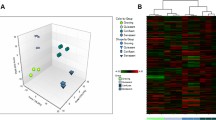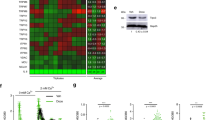Abstract
Carbohydrate metabolism changes during cellular senescence. Cytosolic malate dehydrogenase (MDH1) catalyzes the reversible reduction of oxaloacetate to malate at the expense of reduced nicotinamide adenine dinucleotide (NADH). Here, we show that MDH1 plays a critical role in the cellular senescence of human fibroblasts. We observed that the activity of MDH1 was reduced in old human dermal fibroblasts (HDFs) [population doublings (PD) 56], suggesting a link between decreased MDH1 protein levels and aging. Knockdown of MDH1 in young HDFs (PD 20) and the IMR90 human fibroblast cell line resulted in the appearance of significant cellular senescence features, including senescence-associated β-galactosidase staining, flattened and enlarged morphology, increased population doubling time, and elevated p16INK4A and p21CIP1 protein levels. Cytosolic NAD/NADH ratios were decreased in old HDFs to the same extent as in MDH1 knockdown HDFs, suggesting that cytosolic NAD depletion is related to cellular senescence. We found that AMP-activated protein kinase, a sensor of cellular energy, was activated in MDH1 knockdown cells. We also found that sirtuin 1 (SIRT1) deacetylase, a controller of cellular senescence, was decreased in MDH1 knockdown cells. These results indicate that the decrease in MDH1 and subsequent reduction in NAD/NADH ratio, which causes SIRT1 inhibition, is a likely carbohydrate metabolism-controlled cellular senescence mechanism.






Similar content being viewed by others
Abbreviations
- MDH1:
-
Cytosolic malate dehydrogenase
- MDH2:
-
Mitochondrial malate dehydrogenase
- NAD:
-
Nicotinamide adenine dinucleotide
- NADH:
-
Reduced nicotinamide adenine dinucleotide
- AMPK:
-
AMP-activated protein kinase
- SIRT1:
-
Sirtuin (silent mating type information regulation 2 homolog) 1
- HIC1:
-
Hypermethylated in cancer 1
- HDFs:
-
Human dermal fibroblasts
- PD:
-
Population doublings
- ROS:
-
Reactive oxygen species
References
Ahmed EK, Rogowska-Wrzesinska A, Roepstorff P, Bulteau AL, Friguet B (2010) Protein modification and replicative senescence of WI-38 human embryonic fibroblasts. Aging Cell 9:252–272
Arai T, Nakamura M, Magori E, Fukuda H, Sako T (2003) Decrease in malate dehydrogenase activities in peripheral leucocytes of type 1 diabetic dogs. Res Vet Sci 74:183–185
Bayreuther K, Rodemann HP, Francz PI, Maier K (1988) Differentiation of fibroblast stem cells. J Cell Sci Suppl 10:115–130
Braidy N, Guillemin GJ, Mansour H, Chan-Ling T, Poljak A, Grant R (2011) Age related changes in NAD+ metabolism oxidative stress and Sirt1 activity in wistar rats. PLoS ONE 6:e19194
Canto C, Gerhart-Hines Z, Feige JN, Lagouge M, Noriega L, Milne JC, Elliott PJ, Puigserver P, Auwerx J (2009) AMPK regulates energy expenditure by modulating NAD+ metabolism and SIRT1 activity. Nature 458:1056–1060
Chen WY, Wang DH, Yen RC, Luo J, Gu W, Baylin SB (2005) Tumor suppressor HIC1 directly regulates SIRT1 to modulate p53-dependent DNA-damage responses. Cell 123:437–448
Collado M, Blasco MA, Serrano M (2007) Cellular senescence in cancer and aging. Cell 130:223–233
Dho SH, Kwon KS (2003) The Ret finger protein induces apoptosis via its RING finger-B box-coiled-coil motif. J Biol Chem 278:31902–31908
Dimri GP, Lee X, Basile G, Acosta M, Scott G, Roskelley C, Medrano EE, Linskens M, Rubelj I, Pereira-Smith O et al (1995) A biomarker that identifies senescent human cells in culture and in aging skin in vivo. Proc Natl Acad Sci USA 92:9363–9367
Dong YH, Yao JL, Atkinson RG, Putterill JJ, Morris BA, Gardner RC (2000) MDH1: an apple homeobox gene belonging to the BEL1 family. Plant Mol Biol 42:623–633
Easlon E, Tsang F, Skinner C, Wang C, Lin SJ (2008) The malate-aspartate NADH shuttle components are novel metabolic longevity regulators required for calorie restriction-mediated life span extension in yeast. Genes Dev 22:931–944
Fan YY, Kohno M, Hitomi H, Kitada K, Fujisawa Y, Yatabe J, Yatabe M, Felder RA, Ohsaki H, Rafig K, Sherajee SJ, Noma T, Nishiyama A, Nakano D (2011) Aldosterone/mineralocorticoid receptor stimulation induces cellular senescence in the kidney. Endocrinology 152:680–688
Finkel T, Serrano M, Blasco MA (2007) The common biology of cancer and ageing. Nature 448:767–774
Guo L, Xie B, Mao Z (2012) Autophagy in premature senescent cells is activated via AMPK pathway. Int J Mol Sci 13:3563–3582
Haendeler J, Hoffmann J, Brandes RP, Zeiher AM, Dimmeler S (2003) Hydrogen peroxide triggers nuclear export of telomerase reverse transcriptase via Src kinase family-dependent phosphorylation of tyrosine 707. Mol Cell Biol 23:4598–4610
Hipkiss AR (2008) Energy metabolism, altered proteins, sirtuins and ageing: Converging mechanisms? Biogerontology 9:49–55
Imai S, Armstrong CM, Kaeberlein M, Guarente L (2000) Transcriptional silencing and longevity protein Sir2 is an NAD-dependent histone deacetylase. Nature 403:795–800
Jarskog LF, Glantz LA, Gilmore JH, Lieberman JA (2005) Apoptotic mechanisms in the pathophysiology of schizophrenia. Prog Neuropsychopharmacol Biol Psychiatry 29:846–858
Jiang JC, Jaruga E, Repnevskaya MV, Jazwinski SM (2000) An intervention resembling caloric restriction prolongs life span and retards aging in yeast. FASEB J 14:2135–2137
Joh T, Takeshima H, Tsuzuki T, Setoyama C, Shimada K, Tanase S, Kuramitsu S, Kagamiyama H, Morino Y (1987) Cloning and sequence analysis of cDNAs encoding mammalian cytosolic malate dehydrogenase. Comparison of the amino acid sequences of mammalian and bacterial malate dehydrogenase. J Biol Chem 262:15127–15131
Jones RG, Plas DR, Kubek S, Buzzai M, Mu J, Xu Y, Birnbaum MJ, Thompson CB (2005) AMP-activated protein kinase induces a p53-dependent metabolic checkpoint. Mol Cell 18:283–293
Knecht M, Regitz-Zagrosek V, Pleissner KP, Jungblut P, Steffen C, Hildebrandt A, Fleck E (1994) Characterization of myocardial protein composition in dilated cardiomyopathy by two-dimensional gel electrophoresis. Eur Heart J 15 Suppl D: 37–44
Krishnamurthy J, Torrice C, Ramsey MR, Kovalev GI, Al-Regaiey K, Su L, Sharpless NE (2004) Ink4a/Arf expression is a biomarker of aging. J Clin Invest 114:1299–1307
Lakowski B, Hekimi S (1998) The genetics of caloric restriction in Caenorhabditis elegans. Proc Natl Acad Sci USA 95:13091–13096
Langley E, Pearson M, Faretta M, Bauer UM, Frye RA, Minucci S, Pelicci PG, Kouzarides T (2002) Human SIR2 deacetylates p53 and antagonizes PML/p53-induced cellular senescence. EMBO J 21:2383–2396
Lee SM, Kim JH, Cho EJ, Youn HD (2009) A nucleocytoplasmic malate dehydrogenase regulates p53 transcriptional activity in response to metabolic stress. Cell Death Differ 16:738–748
Lehrmann E, Hyde TM, Vawter MP, Becker KG, Kleinman JE, Freed WJ (2003) The use of microarrays to characterize neuropsychiatric disorders: postmortem studies of substance abuse and schizophrenia. Curr Mol Med 3:437–446
Magori E, Nakamura M, Inoue A, Tanaka A, Sasaki N, Fukuda H, Mizutani H, Sako T, Kimura N, Arai T (2005) Malate dehydrogenase activities are lower in some types of peripheral leucocytes of dogs and cats with type 1 diabetes mellitus. Res Vet Sci 78:39–44
Mair W, Goymer P, Pletcher SD, Partridge L (2003) Demography of dietary restriction and death in Drosophila. Science 301:1731–1733
Mali Y, Zisapels N (2008) Gain of interaction of ALS-linked G93A superoxide dismutase with cytosolic malate dehydrogenase. Neurobiol Dis 32:133–141
McElwee JJ, Schuster E, Blanc E, Thornton J, Gems D (2006) Diapause-associated metabolic traits reiterated in long-lived daf-2 mutants in the nematode Caenorhabditis elegans. Mech Ageing Dev 127:458–472
Mohazzab HK, Kaminski PM, Wolin MS (1997) Lactate and PO2 modulate superoxide anion production in bovine cardiac myocytes: potential role of NADH oxidase. Circulation 96:614–620
Rai P, Onder TT, Young JJ, McFaline JL, Pang B, Dedon PC, Weinberg RA (2009) Continuous elimination of oxidized nucleotides is necessary to prevent rapid onset of cellular senescence. Proc Natl Acad Sci USA 106:169–174
Sejersen H, Rattan SIS (2009) Dicarbonyl-induced accelerated aging in vitro in human skin fibroblasts. Biogerontology 10:203–211
Sugrue MM, Shin DY, Lee SW, Aaronson SA (1997) Wild-type p53 triggers a rapid senescence program in human tumor cells lacking functional p53. Proc Natl Acad Sci USA 94:9648–9653
Tanaka T, Inazawa J, Nakamura Y (1996) Molecular cloning and mapping of a human cDNA for cytosolic malate dehydrogenase (MDH1). Genomics 32:128–130
Van Rechem C, Boulay G, Leprince D (2009) HIC1 interacts with a specific subunit of SWI/SNF complexes, ARID1A/BAF250A. Biochem Biophys Res Commun 385:586–590
Vawter MP, Shannon Weickert C, Ferran E, Matsumoto M, Overman K, Hyde TM, Weinberger DR, Bunney WE, Kleinman JE (2004) Gene expression of metabolic enzymes and a protease inhibitor in the prefrontal cortex are decreased in schizophrenia. Neurochem Res 29:1245–1255
Vaziri H, Dessain SK, Ng Eaton E, Imai SI, Frye RA, Pandita TK, Guarente L, Weinberg RA (2001) hSIR2(SIRT1) functions as an NAD-dependent p53 deacetylase. Cell 107:149–159
Wang W, Yang X, Lopez de Silanes I, Carling D, Gorospe M (2003) Increased AMP:ATP ratio and AMP-activated protein kinase activity during cellular senescence linked to reduced HuR function. J Biol Chem 278:27016–27023
Wang CJ, Hu CP, Xu KP, Tan GS, Li YJ (2010) Effects of selaginellin on homocysteine-induced senescence in human umbilical vein endothelial cells. J Cardiovasc Pharmacol 55:560–566
Wright WE, Shay JW (1995) Time, telomeres and tumours: Is cellular senescence more than an anticancer mechanism? Trends Cell Biol 5:293–297
Yarian CS, Toroser D, Sohal RS (2006) Aconitase is the main functional target of aging in the citric acid cycle of kidney mitochondria from mice. Mech Ageing Dev 127:79–84
Young JJ, Patel A, Rai P (2010) Suppression of thioredoxin-1 induces premature senescence in normal human fibroblasts. Biochem Biophys Res Commun 392:363–368
Yu BP (2006) Why calorie restriction would work for human longevity. Biogerontology 7:179–182
Yu SW, Wang H, Poitras MF, Coombs C, Bowers WJ, Federoff HJ, Poirier GG, Dawson TM, Dawson VL (2002) Mediation of poly(ADP-ribose) polymerase-1-dependent cell death by apoptosis-inducing factor. Science 297:259–263
Zee RY, Castonguay AJ, Barton NS, Germer S, Martin M (2010) Mean leukocyte telomere length shortening and type 2 diabetes mellitus: a case–control study. Transl Res 155:166–169
Zhang Q, Wang S-Y, Fleuriel C, Leprince D, Rocheleau JV, Piston DW, Goodman RH (2007) Metabolic regulation of SIRT1 transcription via a HIC1:CtBP corepressor complex. Proc Natl Acad Sci USA 104:829–833
Zu Y, Liu L, Lee MY, Xu C, Liang Y, Man RY, Vanhoutte PM, Wang Y (2010) SIRT1 promotes proliferation and prevents senescence through targeting LKB1 in primary porcine aortic endothelial cells. Circ Res 106:1384–1393
Zwerschke W, Mazurek S, Stockl P, Hutter E, Eigenbrodt E, Jansen-Durr P (2003) Metabolic analysis of senescent human fibroblasts reveals a role for AMP in cellular senescence. Biochem J 376:403–411
Acknowledgments
This study was supported by grants from National Research Foundation of Korea (20110030133, 20110018053, and 20110027762, K.-S. K.) and a grant from the National R&D Program for Cancer Control, Ministry of Health & Welfare, Republic of Korea (12201901-14924, K.-S. K.). The authors thank Hong-Duk Youn for reagents and valuable comments.
Author information
Authors and Affiliations
Corresponding author
Additional information
Seung-Min Lee and So Hee Dho contributed equally to this study.
Rights and permissions
About this article
Cite this article
Lee, SM., Dho, S.H., Ju, SK. et al. Cytosolic malate dehydrogenase regulates senescence in human fibroblasts. Biogerontology 13, 525–536 (2012). https://doi.org/10.1007/s10522-012-9397-0
Received:
Accepted:
Published:
Issue Date:
DOI: https://doi.org/10.1007/s10522-012-9397-0




